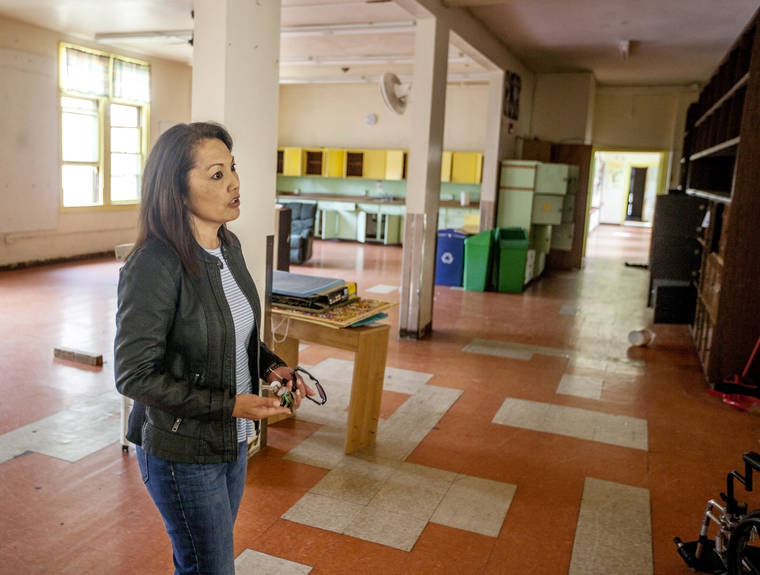
Sharon Hirota, executive assistant to Mayor Harry Kim. (HOLLYN JOHNSON/Tribune-Herald)
HILO — An executive assistant to Mayor Harry Kim told state lawmakers Tuesday the number of homeless people on Hawaii Island is decreasing, but “there is still much work that needs to be done.”
Sharon Hirota made the remarks during her presentation at an informational briefing of the House Committee on Human Services and Homelessness and the Senate Committee on Human Services. The committees are chaired, respectively, by Rep. Joy San Buenaventura and Sen. Russell Ruderman, both Puna Democrats. The briefing at the state capitol in Honolulu was dubbed “Hawaii Homelessness Summit 2020.”
“Although we are seeing the numbers decrease, our shelters, emergency shelters, as well as our transitional housing units, are always at full capacity,” Hirota said. “Our monthly reports indicate we continue to see an increase in the numbers of singles and families moving to permanent housing. But this positive result documents the work of our public and private collaboration. There continues to be a number of individuals that enter our system for the first time experiencing homelessness, so we need to address that.”
Hirota told lawmakers the county in June entered into an agreement to allow the 20 tiny housing units erected in Pahoa in 2018, which are no longer occupied by survivors of the Kilauea eruption, to be used “for general homelessness, and so we’ve added a number of shelter beds in the Pahoa area addressing homelessness.”
Hirota noted the Family Assessment Center in Puna, an emergency shelter of tiny homes that serves nine families at any given time, “has since Day One has been 100% occupied.”
“As of Nov. 30, we’ve served 24 families, seven who have exited to permanent housing, four who have moved on to transitional housing,” she said. “… We’ve served a total of 44 adults and 40 children … 24 have been between the ages of zero and five.”
Hirota said the Keolahou Emergency Shelter and Assessment Center on the Rainbow Drive site of the former Hilo Hospital — converted after the county received in $2.5 million Ohana Zone funding from the state for the project — has also been working at capacity since opening in October.
She noted Keolahou also is working to double its capacity of beds for homeless men to 50 and provide permanent housing.
“In addition, there is 20,000 square feet available on the same site that the county is hoping to partner with other partners to bring behavior and mental health services on site,” Hirota said.
Hirota said the county is seeking increased funding for the rent-supplement program currently managed by the Hawaii Public Housing Authority.
“Our ask for Hawaii Island is to provide $1.1 million, which we anticipate will provide 24 months of housing for a hundred families on our island (and) expand the funding of the mobile outreach health teams, which will address the hardest-to-reach and high-risk homeless families and individuals,” she said.
According to Hirota, the county is the final design stages of the proposed Kukuiola project in West Hawaii and hopes to break ground this spring for 16 tiny home shelter beds, an assessment center, community center and shared restroom and kitchen facilities in the first of four planned phases of construction.
Brandee Menino, CEO of Hope Services in Hilo, appeared at Tuesday’s briefing in her volunteer capacity as chairwoman of Bridging the Gap, a group of organizations on the neighbor islands working to standardize the assessment process for those seeking homeless services.
“In the last few years, we’ve transformed the system to have a common assessment tool, no matter what organization (homeless individuals) come to seek help,” Menino said. “We’re asking the same questions (so) people who are on the streets are not saying the same story over and over. We’re able to see that information across organizations.”
Menino also shared some numbers for Hawaii Island compiled by Bridging the Gap for Fiscal Year 2019, which ended June 30, 2019.
Her statistics include 1,324 homeless people served in Hawaii County, with the average stay in an emergency shelter at 91 days, which Menino said was the lowest on the neighbor islands, but about three times as long as the goal. Of those, 715 people moved into permanent housing, a 70% exit rate.
Among those served were 223 families with children, with 57% of those families led by single mothers. Thirty-eight percent of the family members are children, with 39% of the keiki aged 5 or under.
Menino also addressed what she called a longstanding misconception that the majority of homeless in Hawaii County are recent arrivals from out of state.
She said 77% of those seeking services have lived in Hawaii 20-plus years, with only 3% having lived in Hawaii less than a year. She said 4% of the Big Island’s homeless are U.S. military veterans, and 7% are kupuna aged 60 and older.
Lt. Gov. Josh Green, a Kona Community Hospital emergency room physician, noted the detrimental impact homelessness in Hawaii’s parks, streets and beaches has on tourism, Hawaii’s No. 1 industry.
“You know that there are over 10,000 on any given day, but 15,000 individuals sought services in the year,” Green told lawmakers.
Green added the average life expectancy of chronically homeless individuals in Hawaii is 53, and praised the efforts of those providing services.
He said he believes the “missing link” in solving homelessness in Hawaii is Kauhale — clusters of tiny homes and communal facilities patterned after a program in Austin, Texas, that drastically reduced homelessness among military veterans there.
“If you want to get to the chronically homeless, the individuals that make up most of the cost, the sickest individuals that are the most challenging, the panicked on the streets — they’re occupying the parks and the streets — you’re going to have to (create) tiny villages or some form of that, which, in my opinion, is what was envisioned as part of the Ohana Zone initiative from the outset,” Green said.
